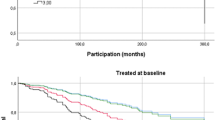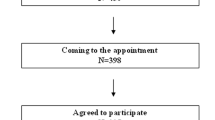Abstract
Previous works using ambulatory blood pressure (BP) monitoring demonstrated that independently of the mean level of BP, the variability in BP, or the day–night range, could have prognostic significance. We have also found that the value of BP on rising in the morning is strongly correlated with left ventricular mass of hypertensive individuals independently of the 24-h value. In the present study, we sought its predictive value for cardiovascular complications in a cohort of hypertensive patients. The population studied belongs to a cohort of initially untreated hypertensive patients recruited since 1983 and followed for more than 5 years. Patients were then treated and followed by their family doctor. At entry, all patients were equipped with a device to measure ambulatory BP. They were requested to trigger a measurement manually on rising in the morning (arising BP). The data on their outcome were collected by a physician unaware of the initial state of the patients. A total of 256 patients have been followed up for 5 years or more, 19 were lost to follow-up. The mean follow-up period was 84 ± 29 months. Cardiovascular complications were recorded in 23 individuals. The arising systolic BP (SBP) was significantly higher in the group who presented a complication. In a stepwise discriminant analysis including age, office, fitting, arising and 24-h average SBPs only age and arising SBP entered the equation. In conclusion, the single BP value measured by an ambulatory device on rising in the morning seems more discriminant of future cardiovascular events than the value of BP measured on fitting the device or the average of three measurements taken under standardised conditions in the hospital or office.
This is a preview of subscription content, access via your institution
Access options
Subscribe to this journal
Receive 12 digital issues and online access to articles
$119.00 per year
only $9.92 per issue
Buy this article
- Purchase on Springer Link
- Instant access to full article PDF
Prices may be subject to local taxes which are calculated during checkout
Similar content being viewed by others
References
The sixth report of the Joint National Committee on prevention, detection, evaluation and treatment of high blood pressure Arch Intern Med 1997 157 2413–2445
O’Brien E, Sheridan J, O’Malley K Dippers and non dippers Lancet 1988 2 397
Ohkubo T et alRelation between nocturnal decline in blood pressure and mortality. The Ohasama Study Am J Hypertens 1997 10 1201–1207
Gosse P, Ansoborlo P, Lemetayer P, Clementy J Left ventricular mass is better correlated with arising blood pressure than with office or occasional blood pressure Am J Hypertens 1997 10 505–510
Devereux RB, Reichek N Echocardiographic determination of left ventricular mass in man: anatomic validation of the method Circulation 1977 5 613–618
De Simone G,et alEffects of growth on variability of left ventricular mass: assessment of allometric signals in adults and children and their capacity to predict cardiovascular risk J Am Coll Cardiol 1995 25 1056–1062
Graettinger WR, Lipson HL, Cheung DG, Weber MA Validation of portable non invasive blood pressure monitoring devices: comparisons with intra-arterial and sphygmomanometer measurements Am Heart J 1998 116 1155–1160
O’Brien E, Mee F, Atkins N, O’Malley K Accuracy of the Novacor DIASYS 200 determined by the British Hypertension Society protocol J Hypertens 1991 9 569–570
Gosse P, Lamaison C, Roudaut R, Dallocchio M Ambulatory blood pressure monitoring, values in normotensivepatients and suggestions for interpretation Therapie 1991 46 305–309
Julius S, Brant D, Krause L, Buda A Neurogenic pressor episodes fail to cause hypertension but do induce cardiac hypertrophy Hypertension 1989 13 422–429
Pickering TG Diurnal, ultradian and seasonal rhythm in blood pressure. In: Pickering TG (ed) Ambulatory Monitoring and Blood Pressure Variability Science Press: London 1991 pp. 5.1–5.15
Kuwajima I, Mitani K, Miyao M, Suzuki Y, Kuramoto K, Ozawa T Cardiac implications of the morning surge in blood pressure in elderly hypertensivepatients: relation to arising time Am J Hypertens 1995 8 29–33
Khoury AF, Sunderajan P, Kaplan NM The early morning rise in blood pressure is related mainly to ambulation Am J Hypertens 1992 5 339–344
Dodt C et alPlasma epinephrine and norepinephrine concentrations of healthy humans associated with nightime sleep and morning arousal Hypertension 1997 30 71–76
Muller J et alCircadian variation in the frequency of onset of acute myocardial infarction N Engl J Med 1985 313 1315–1322
Muller JEet al,and the MILIS study groupCircadian variation in the frequency of sudden cardiac death Circulation 1987 75 131–138
Julius S Sympathetic hyperactivity and coronary risk in hypertension. Corcoran lecture Hypertension 1993 21 886–893
Palatini P, Julius S Heart rate and the cardiovascular risk J Hypertens 1997 15 3–17
Staessen JA et alPredicting cardiovascular risk using conventional versus ambulatory blood pressure in olderpatients with systolic hypertension JAMA 1999 282 539–546
Author information
Authors and Affiliations
Corresponding author
Rights and permissions
About this article
Cite this article
Gosse, P., Cipriano, C., Bemurat, L. et al. Prognostic significance of blood pressure measured on rising. J Hum Hypertens 15, 413–417 (2001). https://doi.org/10.1038/sj.jhh.1001187
Received:
Revised:
Accepted:
Published:
Issue Date:
DOI: https://doi.org/10.1038/sj.jhh.1001187
Keywords
This article is cited by
-
A meta-analysis of randomized trials of telmisartan versus losartan for reduction of ambulatory blood pressure
Hypertension Research (2013)
-
Diurnal blood pressure variation and cardiovascular prognosis in a community-based study of Ohasama, Japan
Hypertension Research (2010)



